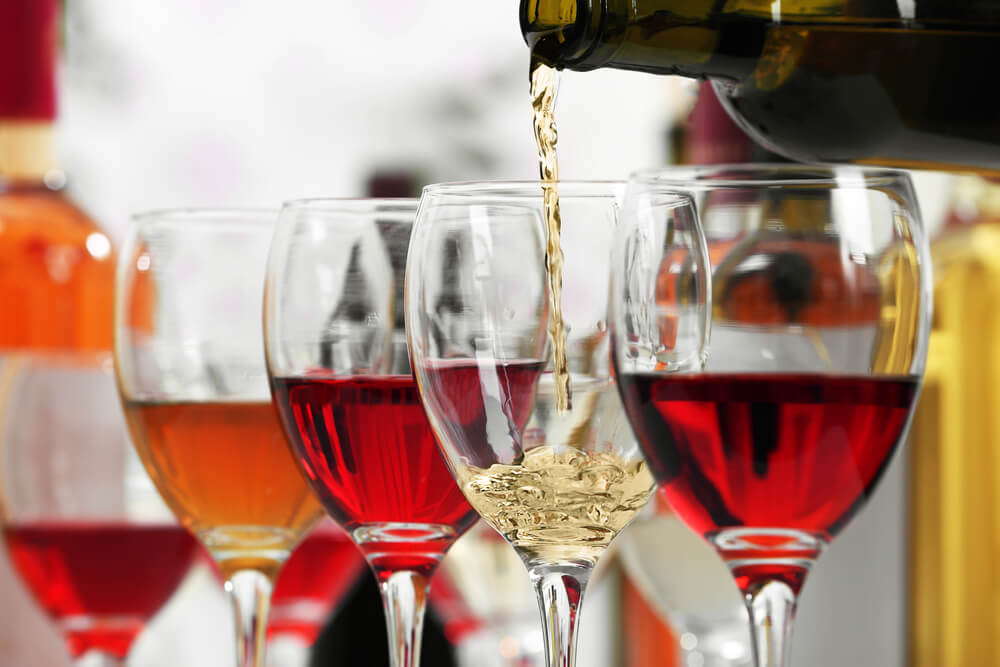Do you ever find yourself struggling for things to discuss when hosting a wine tasting or dinner party? After you introduce the wine, you may feel awkward in the silence that follows. And that’s exactly why we created this post: To give you good, wine-related conversation starters. Plus, we’re willing to bet that you’ll be amazed (as we were!) by some of the following fun & fascinating wine facts:
Fun Wine Facts
- National Wine Day is celebrated annually on May 25th—not that you need an excuse to pour a glass of wine!
- There are many types of white wine, but the most popular are these main nine varieties: Chardonnay, Chenin Blanc, Moscato, Pinot Blanc, Pinot Grigio, Riesling, Sauvignon Blanc, Semmilon, Viognier.
- The seven most popular red wine grapes are: Cabernet Sauvignon, Grenache, Malbec, Merlot, Pinot Noir, Sangiovese, Syrah, and Zinfandel.
- White wine doesn't necessarily come from white grapes. What makes the wine “white” is the fermentation process. In white wine, the grapes are pressed and only the juice is fermented.
- In red wine, both the juice and parts of the grape (such as skin and even stems) are fermented together which imparts to the wine a robust flavor and a darker coloring.
- Tannins are the bitter chemical that exist inside of the grape skin, seeds, and stems.
- White wines have fewer tannins than red wines, which makes white wines “easier” to drink.

- A full-bodied wine means how heavy the wine feels in your mouth. A wine's body is the result of tannins, sugar, acidity, and other components.
- France is the number one producer of wine in the world, followed by Italy and Spain.
- California is the 4th largest producer of wine in the world.
- California has over 4,500 wineries.
- California produces over 80% of all U.S. wines.
- Oregon, Washington, and New York follow behind California as major wine producers in the United States.
- There's at least one winery in every state in the US.
- Chardonnay is the most planted grape variety in California.
- Wine grapes have thicker skin than table grapes.
- Only wines produced in the Champagne region of France can be called “champagne.” The rest are considered sparkling wines.
- Wine is fat free.
- Green grapes are used to make white wines.
- The majority of grapes have colorless juice.
- Red wine gets its color during the fermentation process.
- Because grape juice is usually clear, some white wines can come from black grapes.
- Because it contains antioxidants known as resveratrol (found primarily in the skin of a grape), red wine is good for heart health.
- White wine is good for your health, too. Drinking white wine can actually strengthen your lung tissues and ward off lung disease.
- For good lungs and a good heart, science suggests you should drink a glass of both white and red wines regularly.
- Traditionally, white wine is served before red wine because whites contain less tannins and are lighter bodied. This preps your palette for a fuller bodied wine later.
- It takes three years (sometimes four) for a grape wine to produce its first harvest.
- To chill your wine faster, add salt to the ice water in your bucket. Salt decreases the water's temperature quickly.
- Most white wines have fewer calories than red wines.
- However, sweeter whites (like Moscato) tend to have more calories than the average red.
- When compared to red wines, white wines contain less alcohol.
- White wines get darker when they age.
- Red wines lose color when they age.
- White wines are less likely to produce a hangover than red wines (because whites have less alcohol and tannins).
- Women are more likely to be intoxicated by wine than men because women have more fat and men have more water. Alcohol can more easily be distributed in water, but with less water, there's a greater concentration of alcohol.
- Storing your corked wine bottles standing up can cause your wine to age and eventually more rapidly. Corks are designed to maintain constant contact with the wine. Otherwise, the cork will dry and allow air to seep in.
- Wineries use automated lasers to shoot laser beams at birds. This harmless device protects their grapes and is more efficient than other bird repellents, like netting.
- The fear of wine is called oenophobia, and it is real. People with oenophobia experience classic symptoms of anxiety, such as heart palpitations and shortness of breath when they encounter wine or even think of wine. Why the fear? Most commonly, oenophobics are afraid of getting intoxicated to the point of vomiting. Others are afraid of choosing the wrong wine.
- Your DNA can affect your enjoyment of wine. In the human body, 25 genes encode taste receptors. In a study, people with two copies of the most sensitive version of the TASR38 gene were more likely to perceive alcohol as bitter and undesirable.
- Moderate wine consumption has been shown to reduce cognitive decline and lower the risk of dementia.
- Grape juice self-ferments automatically.
- When traveling to an area where the water may be unsafe, commercially bottled wine is normally a safe alternative. Wine contains a high level of alcohol which can kill germs.
- Out of the over 400 species of oak, only 20 species are used to make wine barrels for aging wine.
- At harvest, the average age of an oak tree that's used for wine barrels is 170 years.
- One ton of grapes produces 720 bottles of wine.
- It takes approximately 3 pounds of grapes to produce one bottle of wine.
- One vine of grapes can produce four bottles of wine annually.
- The world's oldest wine cellar can be found in Armenia and dates back to 3,500 BC.
- The average American drinks just over 3 gallons of wine each year.
- The average Portuguese drinks just over 16 gallons of wine each year.
- The majority of wines (over 90%) are meant to be consumed within one year. Not all wines improve with age.
- Red wine has also been linked to a reduction in gum disease due to the micronutrient polyphenol, which guards against bad bacteria that causes plaque and cavities.
- Smelling is the most important part of enjoying wine. That's because your sense of smell is over 10,000 times more sensitive than your sense of taste. This is why you should always smell wine.
- The best way to store your wine glasses is rim side up because the rim is the most delicate part of the glass, and can easily be chipped with too much pressure.
- Wine glasses are held by the steam to prevent warming the wine.
- Sparkling and light bodied white wines should be served ice cold, between 38° and 45° F.
- White wine should be served between 49° to 55° F.
- Red wine should be served between 62° to 68° F.
- The Ancient Egyptian pharaoh King Tut was buried with 26 jars of red wine.
- When measured in metric tons, grapes are the fifth most produced plants in the world, behind bananas, watermelons, apples, and oranges.
- In 2019, over 77 million metric tons of grapes were produced.
- The largest wine bottle in the world is known as the Nebuchadnezzar, after an ancient king. This bottle is equal to 20 regular-sized bottles.

- Champagne and sparkling wine bottles are made from thicker glass to protect against the increased pressure of the carbonation.
- When the champagne goes into a bottle, it's flat like other white wines. However, when in the bottle, champagne undergoes a second fermentation process that creates its trademark bubbliness.
Do You Have a Wine Fact That We’re Missing?
We’d love to add to our list. If you know of any other fascinating fact about wine, share it with us here.


